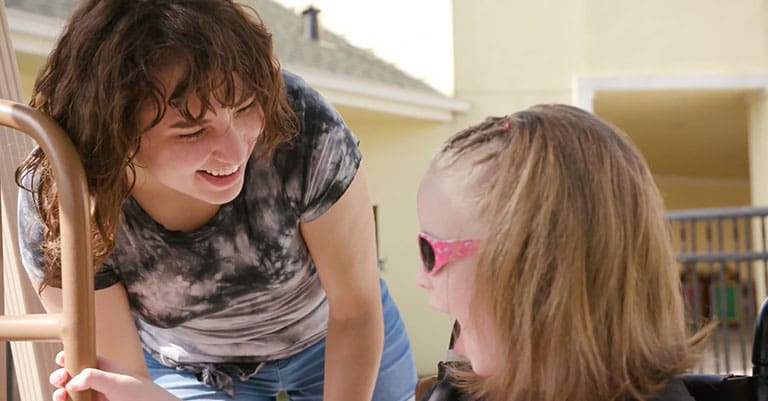After a brain injury, most individuals require rehabilitation to regain strength and skills. The process at Nexus Children’s Hospital, is upon admission, the child is evaluated, and referrals are made to start a variety of rehabilitation disciplines, including occupational, physical, and speech therapy. However, the severity of a patient’s brain injury impacts the level of therapy the team recommends.
Ryan H. McFarland, OTR, MOT, is the Director of Rehabilitation at Nexus Children’s Hospital. He explains, “We work with patients who are at varying levels of consciousness. Depending on what stage they’re in, the therapy team develops an appropriate plan of care. What I love most about our setting, is our therapists work together across departments to achieve the overall goal of helping patients achieve the highest level of function.”
Levels of function include activities of daily living, or ADLs, which are tasks or actions that bring purpose and meaning to a person’s life. For children, that could be getting ready for school each morning or age appropriate play. Someone who suffered a brain injury needs to relearn skills that will help them complete ADLs, like bathing and grooming, to dressing and toileting.
While increased independence while performing ADLs is the goal, not all patients are ready to work towards that objective. Initially, the therapy team focuses on positioning and stimulation for patients who admit in a disorder of consciousness (DOC), or a state of impaired consciousness including coma, persistent vegetative state (PVS), and minimally conscious state (MCS).
“It’s vital that therapy disciplines are consulted on patients who are unconscious or minimally alert because therapeutic engagement may assist in emergence from the disorder of consciousness,” said Ryan. “During this stage, our team also includes nursing and the patient’s family members, as repetition is important. The more we’re able to do with the patient at the beginning helps set them up for success when they emerge.”
Positioning is also crucial as it reduces the likelihood of the patient developing wounds or contractures. The team performs splinting to prevent contractures that would limit a patient’s range of motion, and therefore, facilitates their ability to participate in therapies later in their journey.
As a brain injured patient is emerging, the first therapy goals for occupational and physical therapy are getting the patient to a sitting position in bed. Doing so allows the patient to be more interactive in his or her environment. Also at this time, the therapy team works to identify any ambulatory devices that the patient may need to move more independently. The speech language pathologist (SLP) will also work with the patient to see how he or she responds to stimuli and assist in developing a consistent form of communication allowing the patient an opportunity to engage with others and improve their quality of life.
“As the child or teen continues to heal, we start to progressively mobilize him or her,” said Ryan. “We typically start with bed mobility, so practicing rolling left and right or sitting up and maintaining balance are often initial functional goals. We like to break everything down to small, achievable steps to keep our patients motivated. We’ll then work on more progressive goals such as dynamic sitting balance, standing and ambulation as appropriate.”
Nexus Children’s Hospital also treats infants and toddlers. The therapy team first evaluates to determine the patient’s developmental stage. They may be considered delayed because of neurological impairments, meaning they haven’t reached certain milestones, like holding their head up, rolling over, or crawling. Physical and occupational therapists work collaboratively to progress the children developmentally.
Similarly, the SLP focuses on feeding and swallowing. They’ll work with patients to improve their ability to latch onto a bottle nipple or improve suck. In partnership with the dietician, they’ll also wean patients from PEG or NG tubes to return to a more normal way of feeding by mouth. Of course, the SLP will also work closely with children who need support with language.
“Our facility takes care of patients that fall through the cracks in our city, our country, and even across other countries,” said Ryan. “What we do takes a total team effort. Patients with neurological injuries need to practice skills and work consistently to improve, and that requires a team effort. Without therapy, some healing would naturally take place. But without rehabilitation and the patient allowing their body and mind to be challenged to improve, the extent of recovery may not be the same.”
